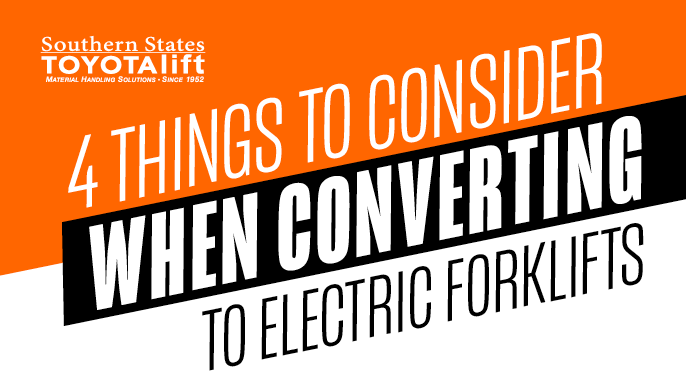4 Things To Consider When Converting to Electric Forklifts
by Theodore Taylor, on Jul 8, 2023 4:46:50 PM
 According to a study by the Electric Power Research Institute, every electric forklift reduces total carbon emissions by 120,000 lbs per 10,000 hours of operation. With the steady improvement of electric forklift power over the last several years, there’s no question that electric forklifts are the greenest option on the market.
According to a study by the Electric Power Research Institute, every electric forklift reduces total carbon emissions by 120,000 lbs per 10,000 hours of operation. With the steady improvement of electric forklift power over the last several years, there’s no question that electric forklifts are the greenest option on the market.
However, they aren’t just good for the environment. With a lower total cost of ownership than IC forklifts, they are a lot easier on your budget.
So it's not surprising that 40% of respondents in an MHI annual survey said electrification was a top focus area for sustainability. If you've been thinking about making the switch, there are a few things to keep in mind for a smooth transition. Read on to learn the 4 things to consider when converting to electric.
Battery Type
The first choice when making the switch to electric is battery type. Currently, two different types of forklift batteries are dominating the market: lead acid and lithium-ion. Which type of battery you choose will significantly affect the steps involved in your conversion to electric.
Lead Acid
Lead acid batteries have been used in industrial equipment for nearly a century. They’re a reliable technology that is relatively inexpensive to produce. This has made them popular in electric forklifts.
However, this older technology comes with some drawbacks. First of all, they require frequent maintenance. Without regular watering and equalizing, these batteries decline rapidly. Additionally, lead acid batteries require extended charging and cool-down periods. This means your fleet will likely need more than one battery per electric forklift to sustain multi-shift operations.
Lithium-Ion
Lithium-ion (Li-ion) forklift batteries are a relatively new technology that offers more flexible charging options. They're compatible with both opportunity charging and rapid charging. Additionally, many Li-ion forklifts utilize regenerative braking. This recaptures energy whenever the forklift brakes, thus extending the battery's run time. These power solutions mean one Li-ion battery per forklift is usually sufficient, even for high-throughput facilities.
Moreover, Li-ion batteries are essentially maintenance-free. This reduces downtime among these forklifts and increases worker productivity. However, Li-ion has a higher upfront cost than lead acid. Although, their total cost of ownership is often lower than both IC and lead acid. For these reasons, we generally recommend investing in a Li-ion fleet when switching from IC to electric.
.png?width=513&height=343&name=3-Wheel%20Electric_8FBE20U_Close-Up_LIB%20Battery_3%20(1).png)
Charger Types
As alluded to above, your choice of electric forklift may offer you a choice of battery chargers. There are 3 common charger types on the market.
Conventional Charging
Conventional charging is ideal for single-shift and two-shift operations. With these chargers, the forklift battery is connected to the charger and left overnight to charge completely. This process takes around 8 hours to complete, with lead acid batteries requiring an additional 8 hours to cool down. Additional batteries would need to be added for two-shift operations. Li-ion batteries can utilize conventional charging methods but often benefit more from the other two options.
Rapid Charging
The decreased internal resistance of Li-ion batteries allows them to accept charge very efficiently. Rapid chargers take advantage of this. They can charge Li-ion batteries from empty to full in about 1 hour. However, forklift batteries are not typically depleted entirely. Thus practical rapid charging returns a Li-ion battery to a working charge in under an hour in most cases.
.png?width=455&height=352&name=Toyota%20Lithium-Ion%20Battery%20Charger_Close-Up_1_edit%20(1).png) These forklift charging stations have greater electrical requirements than other chargers. They require more amps than most electrical infrastructures can provide. Thus, some infrastructural upgrades are usually necessary before installing these chargers.
These forklift charging stations have greater electrical requirements than other chargers. They require more amps than most electrical infrastructures can provide. Thus, some infrastructural upgrades are usually necessary before installing these chargers.
Opportunity Charging
Opportunity charging is one of the hallmarks of Li-ion and flooded batteries. These systems prioritize short charging periods of 10 to 30 minutes or the duration of a worker's break. They don't fully charge either batteries in that time. However, they charge the batteries enough to keep them working until the next break, when they can be charged for another short interval. This pattern of short, frequent charges keeps the forklifts running all day with minimal disturbance in workflow. The Li-ion battery has the advantage of accepting almost double the amps returned during this short period due to the advanced battery technology making it the preferred battery for opportunity charging and multi-shift operations. These chargers can be easily installed with little to no modification to existing electrical infrastructure. Opportunity charging is an excellent choice for organizations looking to optimize uptime.
Employee Training
Anytime equipment changes, updated training is required to keep your team up to speed. While much of their operation is similar to IC forklifts, your electric fleet will have a few unique needs. These center mainly around the battery.
Battery Safety
Train your employees to handle forklift batteries properly. Lead acid, in particular, presents acid spill, splash, and leak hazards. Similarly, charging these batteries can produce explosive hydrogen gas in small quantities. All of these hazards are manageable with proper employee training and a dedicated battery space.
Li-ion batteries do not present the above chemical exposure hazards. However, they can get hot when charging rapidly. Train your staff to monitor battery temperature and take steps to ensure Li-ion batteries remain within acceptable temperatures.
Charging Logistics
No matter which method you choose, batteries take time to charge. For a team used to swapping out LPG tanks, for example, this will alter workflow. Prepare your team for this adjustment by communicating when and where they are expected to charge forklift batteries. Be sure to train them on the proper use of the specific charger used in your facility.
Tagout Procedures
Your facility probably already has tagout procedures for forklifts, but you may need to develop procedures to tagout chargers and batteries. Ensure your staff knows what to look for when inspecting forklift power equipment. If they find something wrong, ensure they understand the procedure for tagging out the equipment.
Return on Investment
One of the common misconceptions about electric forklifts is they are more expensive. It’s true that the upfront cost of electric forklifts is often higher than their IC counterparts. However, the total cost of ownership is generally much lower. To budget appropriately for your new electric fleet, you'll need to determine your return on investment by calculating the total cost of ownership for your existing IC forklifts and comparing it to your proposed electric replacements. To do this, be sure to account for the following:
- Expected forklift lifespan
- Fuel vs. electricity costs
- Maintenance costs and labor
- Available conversion incentives
Government Incentives
While calculating your ROI, be sure to include any available grants or incentives that your state offers. Florida and Georgia have previously offered funds to assist with electric conversion. These programs vary from state to state. So be sure to investigate what incentives are available in your area.
Get Your Free Power Study
Converting to electric is less expensive and easier than you think. Minor adjustments to workflow and an initial investment are all it really takes to start saving money while protecting the environment. Southern States Toyotalift is dedicated to helping you find the simplest path forward. Our expert team will come to your facility to determine your power needs and help you plan the fastest, easiest way to convert to electric. Don’t let fossil fuels clog up your budget. Contact our Solutions Team online or visit one of our helpful locations throughout Georgia and Florida to schedule your free power assessment today.
Florida
Jacksonville
Lakeland
Ocala
Orlando
Tampa
Winter Haven
Georgia
Albany
Macon
Columbus
Valdosta
Further Reading
Different Types of Electric Forklifts And What They’re Used For
Switch to Electric Forklifts: See How Much You’ll Save
3 Common Misconceptions About Electric Forklifts









